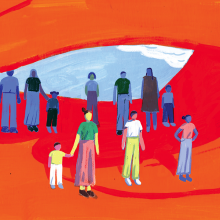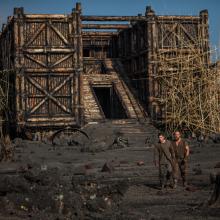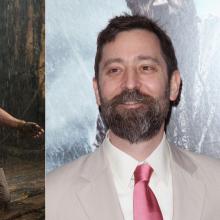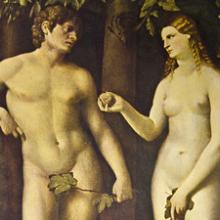Genesis
MANY YOUNG CHRISTIANS grow up with special “adventure Bibles” composed of a curated selection of Genesis stories. Featuring colorfully illustrated characters and simplified, “age-appropriate” plot lines, these stories are admittedly easier for children to absorb. Take, for instance, the adaptation of Genesis 3 found in Zondervan’s The Beginner’s Bible: We meet Adam and Eve walking the arcadian Earth. Their bodies are hidden behind carefully placed branches and auburn waist-length hair. Acting alone, Eve takes a bite of bright red fruit and loses paradise. It’s a simple story. It’s also inaccurate.
Marilynne Robinson’s Reading Genesis presents a much more complicated portrait of the first book of the Bible. She invites us to return to these ancient tales and allow the figures to re-introduce themselves. In Robinson’s telling of Genesis 3, Eve is much more dynamic. She is “the mother of all living” who, alongside Adam, “disobeyed, doubted, tried to deceive,” and as a result, brought about “human agency, responsibility, even freedom.”
“CENTER THE CLAY.” I had one task for class and three hours to complete it.
Take two pounds of raw potential. Place it on the potter’s wheel. Use the strength of your hands and forearms to force the clay into balance.
For the full three hours, I failed. Unable to find the calm point of pressure to rest my human musculature between the universe’s centrifugal and centripetal forces. The clay fought back. It bucked and shimmied, slid and skidded. I pushed and pulled.
The teacher said, finally, “This clay does not yet want to be a bowl. You have not shown it how.” A gentle correction that expertly undermined my fixation with “the primacy of the real,” as French philosopher Gaston Bachelard calls it. Really, shouldn’t I be able to subdue this clay?
In the beginning, Ruth Handler created Barbieland. And Ruth said, “Let there be pink,” and there was pink.
Speech opens a door to previously unknown experiences. In a way, speech — or language — makes and unmakes the world as we know it. When I speak about myself, I tell you the truth of who I am.
So, in an era where people of faith, specifically Christians, are popularizing anti-trans language, it feels like my responsibility to say something — anything — to lift up those of us who identify as transgender and Christian. The truth I want to communicate here is this: God made me to be trans.
WE HAVE SEVERAL readings this month where God creates something out of nothing — or at least out of pretty limited materials. In the opening chapters of Genesis, we see creation birthed from God’s imagination and curiosity. In the story of Sarah and Abraham, a child is conceived in a womb so postmenopausal that the now-pregnant woman can’t help but laugh (Genesis 18). A well appears from nowhere to quench the thirst of a dying woman and her child (Genesis 21:19). God “calls into existence the things that do not exist” (Romans 4:17). And God turns death to life through the mysteries of resurrection (Romans 6:1-11).
This month’s lectionary readings make God’s continuous creation — as well as God’s continual renewal of creation — explicit. But the fact is, once we’re looking for it, all of scripture tells these stories of renewal. God is always creating, re-creating, and reimagining our world. God is always making a way where there was no way before. God continually turns death to life. And, just as importantly, we are called to participate in God’s divine practices of continuous creation, in God’s own divine practice of everyday resurrection.
As we exit a series of some of the higher holy seasons in the liturgical year — Epiphany, Lent, Easter, and Pentecost — June quiets down from such intensity. The slower pace to which (in some places) the warm summer sun calls us can inspire us to seek out everyday resurrection wherever God hides it. How is the Spirit calling you to partner with divine practices of renewal, with everyday resurrections?
RIGHT THERE ON page one, it explains that our job is to exercise careful dominion over the planet, which God has just made and found good. It’s literally job one.
So let’s just list a few of the things that have happened over the last four years in this country to see how we’re doing. The administration has, according to The New York Times:
Dramatically weakened the fuel-economy standards for cars and trucks; canceled a requirement that oil and gas companies even report their methane emissions, at precisely the moment that methane emissions (a key greenhouse gas) are soaring; weakened federal rules to prevent air pollution in national parks; withdrawn from the Paris climate accords, the only global effort to slow climate change; shrunk national monuments to allow for more oil drilling; pushed through plans for pipelines despite massive resistance from farmers, ranchers, and Native Americans in their path; permitted the use of seismic air guns for oil and gas exploration in the Atlantic, despite the danger to marine life that had led to a ban; opened the Arctic National Wildlife Refuge (the largest wildlife refuge in the country) to oil and gas drilling; revoked Obama-era flood standards for new federal projects requiring that sea level rise be considered; reversed Obama-era rules on sport hunting so that it’s now legal to bait grizzly bears with grease-soaked doughnuts; revoked a rule preventing coal companies from dumping mining debris in streams; blocked plans to mandate more efficient light bulbs; stopped payments we’d promised to the Green Climate Fund, which is designed to help poor countries reduce carbon emissions; and restarted the sale of plastic bottles in national parks. Believe me, I could go on.
WHO WOULD HAVE thought that a verse from the first chapter of the Bible would become an “altar call” for a presidential election? Here is our call to faith as we look to Nov. 3: “Then God said, ‘Let us make humankind in our image, according to our likeness.’ ... So God created humankind in [God’s] image” (Genesis 1:26-27).
I believe this text about the creation of humankind in God’s likeness is the foundation of politics for people of faith. It means how we treat other human beings, including our fellow citizens, is a theological matter and not just a political one. Mistreatment of our fellow human beings and citizens is also not just a political problem but an offense to the image of God, an assault on imago dei.
Protecting the image of God in the upcoming election means protecting the voting rights of Americans of color, whose votes some are trying to suppress, deliberately and strategically. The faith community is responding.
Call this hair crazy.
but watch as it grows
outside of your gates
and beyond the walls
you’ve made to contain
me. See as it reaches
higher than anything you
ever thought of me,
shedding every lie of
inferiority.
The resurrected Jesus is recognized not by his words but by his wounds, the wounds of his crucifixion. Herein lies a great irony. The crucifixion has left its indelible marks upon the resurrected one, such that the risen Jesus is recognizable only through them. On the one hand, resurrection has not erased his wounds. On the other hand, Jesus’ wounds no longer define him as a dead criminal, as determined by the state. Jesus doesn’t wince at Thomas’s touch. Even as his wounds remain, Jesus’ body is made whole and new.

Hand scanning the Book of Genesis. Suzanne Tucker / Shutterstock.com
I didn’t see the film Malcolm X in theaters. I waited to see it on video. Big mistake.
I watched it in my home, just off campus from University of Southern California, late at night when everyone else was sleeping. Another big mistake.
At the time I was living in a house with one other black person and a bunch of white and Asian friends. I was attending a mostly white school and a mostly white church and had attended a mostly white institute for urban transformation that was borne out of my church. Ironically, it was there that I was required to read The Autobiography of Malcolm X. But I never read the whole thing, only sections.
So, I sat in the dark living room, lit only by the television screen, and watched Denzel Washington bring Malcolm X to life … by myself. And there, in the dark, Malcolm’s words about Jesus hit me to the core.
What do you want to pass on to your grandchildren? What will you give to future generations?
There’s a special spot on my shelf for books my grandparents handed down to me over the years. I cherish the collection of love poetry my grandfather gave my grandmother for a wedding anniversary decades ago. I treasure my grandfather’s old prayer book and hymnal. Depending on your family history, most of us will have at least a few old treasures from generations before.
Some things pass from one generation to another with special care—a family wedding ring, a chess set from the home country, old pictures. Other items, however, pass with less care and planning. My wife, for instance, has her grandmother’s old cookie jar. It’s made of cheap, simple glass and is completely unremarkable except for the memories of cookies eaten at grandma’s house it evokes.
Families aren’t the only ones thinking of passing things along. Politicians, skilled at tugging heartstrings, speak often of “future generations.”
Where does the violence end? And how did it begin?
In such a moment, we imagine ISIS as “different” from ourselves, a whole distinct category of the species homo sapiens. We did the same with Nazis back in the day, as if genocide’s engineers had not been the brothers and sisters of our own immigrant citizens, as if they were not the grandparents of the amiable Germans and Poles we befriend today. We forget, by the way, our own history of torturing — often burning alive — our own African American citizens, grandchildren of those this nation had enslaved. Our own president condemned ISIS and its grotesque ways, and he also reminded us that the potential for such violence dwells within every society. Naturally his opponents went nuts: they are nothing like weare, they cried.
But we are like they are, and they are like we are. Violence breaks us down.
RECENTLY, several highly publicized events of domestic violence have reminded us of the epidemic proportions of relational abuse. While the focus has been on athletes, abuse has taken place from the halls of Congress to the pulpits of churches. We have also experienced, particularly from church leaders, a vocal outcry against such abuse.
This outcry, however, remains superficial, shallow, and disingenuous if we are not willing to challenge some of our dominant theological assumptions that provide the conceptual framework for the maintenance of this abuse.
Many of the early church fathers affirmed the subservient and secondary status of women and even encouraged the “control” and “forceful instruction” of women in order to maintain conformance to what they saw as God’s “relational design.” Even today, some promise to affirm women only as long as they stay in their “God-ordained place.” In other words, women can expect “favor” only when they remain defined by and conformed to a “divinely” decreed order and hierarchy.
Tragically, this hierarchy is established by the curse and the culture—not the creation and certainly not the Christ. When the curse and the culture establish our doctrine, we embrace “snakeology,” not theology. This snakeology distorts the character of God, relationships, authentic manhood, and authentic womanhood.
A theology of labor involves Genesis 2:15 – “The Lord God took the man and put him in the garden of Eden to till it and keep it.”
Labor is fundamentally a good thing and a theology of labor includes responsible stewardship of the earth’s resources. The first chapter of Genesis is obsessed with telling us that the world is good. As such, God calls us to labor for it, to responsibly keep and care for it.
Of course, labor often involves hard, back breaking work that doesn’t always feel good. Genesis 3 puts forth an explanation that God cursed the earth because of human sin, making labor much more difficult. Whatever we think about that explanation, the Bible is much more interested in a different curse when it comes to labor — how we humans curse one another.
Like everything in this good world, the goodness of labor can be exploited. The prime biblical example of this comes from Exodus, which describes how the Hebrews were exploited as slaves in Egypt.
They were forced to labor.
St. Bonaventure (d. 1274) once said, “Whoever is not enlightened by the splendor of created things is blind; whoever is not aroused by the sound of their voice is deaf; whoever does not praise God for all these creatures is mute; whoever after so much evidence does not recognize the Maker of all things, is an idiot.”[1]
If Bonaventure was right, then we’re all idiots.
The first time I travelled to Rome was an experience second to none. Never, in my young travels, had I ventured to a place so layered with history and significance around every corner that one literally couldn’t escape it. Even the Roman suburbs were historical. We were amped to see it all. Our approach was simple: we would incrementally make our way through the city over the course of 10 days with a plan that would make any explorer proud.
The sheer magnitude of historical and ecclesiastical sites to be seen in the city was overwhelming at best. Then it happened. I had a unique moment near the end of the trip. We’d been walking nonstop through museums, ruins, churches; we’d even heard the pope preach a sermon, when I started to lose my attention. Many travelers or art buffs will resonate with this — there came a point during our endless walk through Rome where I had seen so much beauty and splendor and history that I just started taking it all for granted. The last two days consisted of me walking around blindly and numbly, room-to-room, ruin-to-ruin, as though what I stood before was of little or no value.
I called it “beauty exhaustion.”
Biblical themes have been used throughout history to share the universal struggle of humanity; temptation, rebellion, coming of age, the degradation of the moral compass, courage in the face of humanity, and of course, faith.
William Shakespeare uses biblical elements in his plays. We witness in his writings themes highlighted in David's narrative, Adam and Eve's story, and Cain and Abel's tragedy. These stories are central to the Western canon. We cannot get away from these themes and stories, for they rest in the consciousness of our culture.
The film Noah, directed by Darren Aronofsky, is a daring, powerful, and imaginative retelling of the Noah story. Aronofsky takes the central elements of the biblical narrative and expands the story, as artists are called to do, to allow the audience to witness, not a historical world, but a metaphorical universe where the choices of humanity disrupt the sacred divine rhythm of creation.
I’ll begin by cutting to the chase: Forget most of what you’ve read about Darren Aronofsky’s new film, Noah. It opens Friday. Go see it and decide for yourself.
Having said that, in my opinion Aronofksy’s Noah is a beautiful, powerful, difficult film worthy of the “epic” label. A vivid, visually spectacular reimagining of an ancient story held as sacred by all three Abrahamic religious traditions, it also is the most spiritually nuanced, exquisitely articulated exploration of the ideas of justice and mercy I’ve ever seen on a movie screen.
And despite what you may have heard elsewhere, Noah is deeply, passionately biblical.
Last Sunday in Los Angeles, Cathleen Falsani sat down with Ari Handel, a screenwriter and frequent collaborator with Noah director Darren Aronofsky, with whom he co-wrote the film and the graphic novel, Noah, upon which it was based, to discuss some of the extra-biblical elements of the $150 million movie.
Longtime friends Handel and Aronofsky were suitemates at Harvard University. Before becoming a screenwriter and film producer, Handel was a neuroscientist. He holds a PhD in neurobiology from New York University. He was a producer on Aronofsky’s films Black Swan, The Wrestler, and The Fountain (which he co-wrote with Aronofsky), and had a small role as a Kabbalah scholar in the director’s debut film, 1998’s Pi.
Editor’s Note: The following Q&A contains some spoilers about the film. It has been edited for length.
Last fall, on a Sunday afternoon, as I walked out of the church, a young man tugged on my Franciscan habit. It was Miguel, a member of our Latino choir.
“Father,” he said, “please, pray for the people of my home parish back in El Salvador, especially for one of the priests who has received death threats.”
Startled, I asked: “What is happening there?"
“These priests are organizing against the multinational companies,” he said. “The companies are looking for gold. What will be left for our people? Only poisoned water, a wasteland, and death.”
A few weeks later, I had another similar conversation with a group from Guatemala. Theirs was a similar tale of how indigenous communities were being threatened by mining projects.
As a Catholic and a member of the Franciscan Order, I believe that we are called to “read the signs of the times” and to listen to the cry of the poor and the “groaning” of God’s Creation.
Is Eve all about sex? Or might she want something else? Our popular imagination turns Eve into a receptacle for one set of our fantasies. Our fixation on Eve’s sexuality causes us to overlook the story’s major themes and what they might mean for our common life together. Indeed, biblical scholar Ken Stone shows that Genesis 2-3 has a lot more to say about food than it does about sex. Even if becoming “one flesh” is about sex, and maybe it’s not, there’s all kinds of references in the passage about what the first humans may or may not eat.
The story tells us directly what Eve wants. She doesn’t want to tempt Adam. And she doesn’t want a snake curling suggestively around her body. Eve wants wisdom.
And she gains wisdom.
Let’s review some of the overlooked details in this story.

















